Author: Kevin, the Researcher from BlockBooster
Murad depicted the supercycle of Memecoins, arguing in a way familiar to VCs, including the prospects of altcoins, the shift in the crypto industry, and changes in future trends:
Defined the Memecoin Supercycle, dismissing altcoins that generate only $500 in daily revenue but have valuations as high as $7 billion;
Outlined the golden age of Memecoins, at the cost of definitively concluding the fate of altcoins that have fallen to the bottom but were once laden with bull market myths. “All altcoins are essentially Memecoins, just more complex versions.”
Murad's views may seem radical, and we do not intend to judge them, but his mention of “the trading trends of Memecoins are changing” is worth further exploration. This article will analyze the development of Memecoins that need to build communities and make long-term investments in their early stages, using $MOODENG as an example, while also analyzing the common characteristics of the top five Memecoins recommended by Murad, objectively observing the new trends in Memecoins.
Reviewing $MOODENG
Moo Deng is a small pygmy hippopotamus born on July 10, 2024, at the Khao Kheow Open Zoo in Thailand. After the zoo shared photos of his birth on its official Facebook page, he quickly became a beloved star. Due to Moo Deng's rising popularity online, the zoo's average daily visitor count doubled in early September 2024.
Currently, there are three Memecoins related to Moo Deng: $MOODENG on Solana and Ethereum, and $HIPPO on Sui. The three were launched on September 10, September 15, and September 27, respectively.
First, let’s take a look at the common on-chain data for Solana $MOODENG:
The natural growth of holders is rapid, with bots interspersed
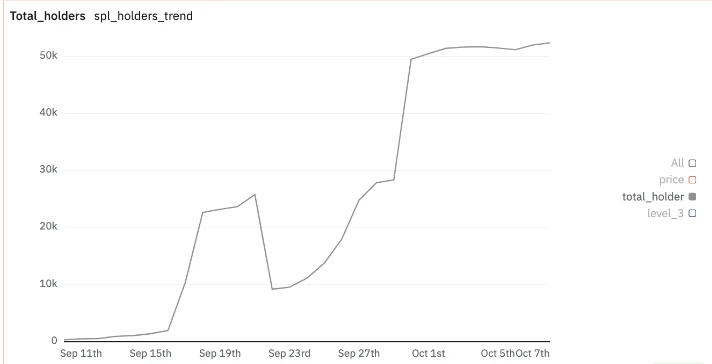
Total address growth of SOL $MOODENG
From the chart showing the growth of total wallet addresses, there are three notable periods of abnormal activity:
First, from September 16 to 18, the number of addresses surged sharply from 1,970 to 22,645;
After three days of natural growth, there was an abnormal drop between September 21 and 22, with the number of addresses decreasing from 25,790 to 9,204;
The second abnormal surge occurred from September 29 to 30, with the number of addresses skyrocketing from 28,344 to 49,502.
Additionally, among the current total of 52,413 addresses, 25,464 addresses have never sold their holdings since their initial purchase, resulting in a diamond hands ratio of 48%.
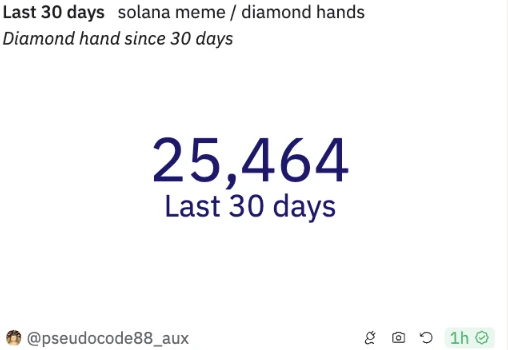
Number of diamond hands addresses for SOL $MOODENG
When we conduct a simple filter on the on-chain address holding levels, we find that the number of addresses with $MOODENG holdings mentioned above is all less than 100. The team quickly and massively deployed nearly 20,000 addresses in a linear fashion within three days, triggering the alert indicators for chain-sweeping bots while maintaining a stable upward price channel, attracting market attention.
Meanwhile, we observe the following three charts, which show the total number of wallet addresses holding $MOODENG, the number of addresses holding 0.0005% $MOODENG (4,950 addresses, worth about $693), the number of addresses holding 0.005% (49,500 addresses, worth about $6,930), and the number of addresses holding 0.05% (495,000 addresses, worth about $69,300). After filtering out bot addresses and raising the minimum holding threshold to 4,950 $MOODENG, we can see a clearer trend: the number of small and medium holders continues to grow steadily, while large holders stopped growing after the 21st.
Focusing on small holdings, we can see that starting from September 16, the number of addresses surged due to the influx of new addresses. As the FOMO effect intensified, the natural growth of small holdings further accelerated, peaking on the 20th. When the team observed this stable natural growth, they removed the bot addresses deployed between the 16th and 18th. As the price of $MOODENG peaked on the 28th, the number of addresses began to decline, synchronizing with the price trend.
The growth of medium holdings slowed after the 18th, with a larger sell-off volume than small holdings after the 28th.
From September 28 to October 6, small holdings decreased by 12.2%, medium holdings decreased by 16.5%, and large holdings decreased by 25.8%.

Growth rate of tiered addresses for SOL $MOODENG
The peak times for the three types of holdings also differ: large holdings peaked on September 21, medium holdings peaked on September 27, and small holdings reached their maximum on September 28.
High Concentration of Chips
Further digging into the on-chain data of $MOODENG reveals that after ignoring the interference of the top 10 holding addresses, the remaining top 5% of addresses hold nearly 90% of the circulating supply. Specifically, the top 5% of addresses held 46% on the 10th, surged to 71% on the 11th, and maintained over 90% between the 21st and 24th. Currently, it is around 85%. Therefore, the holding of $MOODENG tokens is highly concentrated.
Mature Team Operations
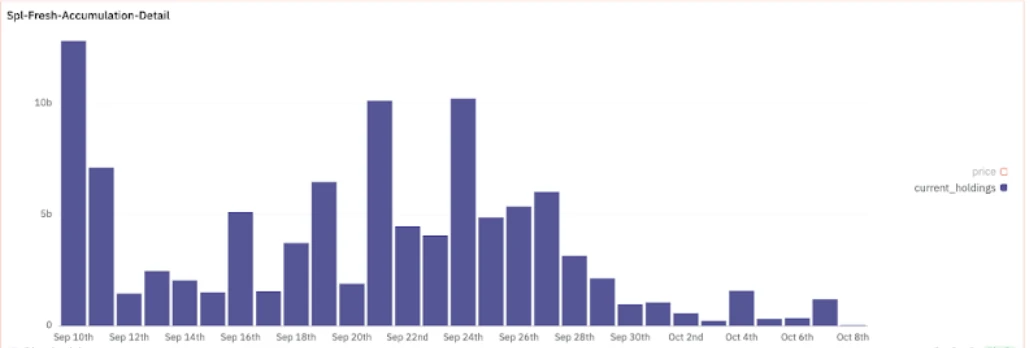
Large purchases by individual addresses of SOL $MOODENG
The team has been continuously buying since the token's inception until the 28th. As shown in the figure, the team accumulated a large number of chips in the first two days, especially on the 10th and 11th, while also achieving significant results in maintaining the candlestick trend. Combining the upper and lower charts, it is visually evident that the team made two strong price pushes on the 21st and 24th, rhythmically breaking through the consolidation range over a three-day period.

Price trend of SOL $MOODENG
Comparing Ethereum $MOODENG
Using the indicators mentioned above to observe the on-chain data of Ethereum $MOODENG, we can find that for retail investors, interest in the token had already waned before Vitalik sold $MOODENG from his wallet, with almost no growth in on-chain addresses, and the team did not actively maintain the community and trend, which is extremely common in clones. In the 10 days prior, the total number of addresses showed no growth, and the team had essentially given up.
Interestingly, during this period, addresses with medium holdings chose to sell tokens as prices continued to decline. From the 25th to the 5th, medium holders were consistently selling to minimize losses. In contrast, retail investors adopted a “buy and hold” strategy.
On October 5, with Vitalik's tweet, FOMO sentiment on the ETH chain was ignited, leading to a sudden surge in small holding addresses. Medium holdings also increased, but after peaking on the 7th, many addresses began to sell, and large holders did the same. From the charts above, it can be seen that large addresses began selling on the 5th, while medium and large holders started selling on the 7th, indicating the team's urgency to offload.
In terms of chip concentration, the concentration of $MOODENG tokens on the ETH chain is not as high as on the SOL chain, but it has been steadily rising since the 5th, peaking at 58.6% on the 8th.
Controlling Token Holding Structure and Trend Patterns: New Ideas for Memecoin Marketing
SOL's $MOODENG did not engage in much KOL promotion; instead, the team focused on promoting their X account. Their core strategy is reflected in controlling the trend patterns of the token. While building the community, they accumulated a large number of tokens early on, achieving a high concentration of chips, and broke through after multiple consolidation phases. In terms of price trend control and trading strategy, the ETH team pales in comparison. The SOL team successfully concentrated control over 90% of the tokens, while the ETH team only controlled 48%. However, controlling chips is a common practice for any Memecoin; it is not that controlling chips is unimportant, but what to do after controlling them is what distinguishes the winners from the losers. In terms of expanding influence, today's Memecoins no longer rely on KOL promotion. For the team, the key is how to artificially trigger these bots and platform indicators. If done correctly, these bots and platforms can become free marketing tools.
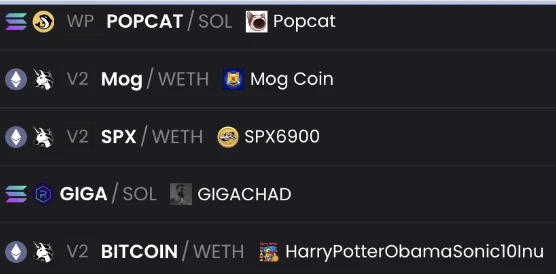
Overview of the top five Memecoins by market cap recommended by Murad
Murad mentioned that when selecting Memecoins, the reference criteria are as follows: mid-cap coins between $5 million and $200 million; located on Solana and Ethereum; and at least six months of history. These criteria can also be understood using the indicators mentioned above, which in my view can be translated into two directions: the team's willingness to maintain the price; and the degree of FOMO they can stimulate among users.
The former refers to the ability of the team/whales/community to maintain prices during declines, forming a prolonged stable consolidation pattern, and to strongly push prices when a breakout is needed. For Memecoins, it is difficult to sustain price increases solely based on user sentiment, as no one can control the buying and selling behavior of retail investors. Therefore, attracting large holders or retail traders ultimately depends on the team's own price behavior on the token, especially during declines and breakouts. Thus, the concentration of chips held by the team/whales suggests, to some extent, the willingness and determination of the team to take action at key price points. Of course, this process also relies on community support; for example, the price trend of $SPX is not strongly correlated with team actions, which stems from Murad's influence. The latter can be analyzed from the increase in the number of user holdings, while observing changes in top holdings can guide us on when to sell.
In terms of the dominance of the top 5%, the five tokens recommended by Murad are all strong tokens controlled by teams and large holders. Among them, $POPCAT and $GIGA have a concentration rate exceeding 85%. The remaining three are also above 60%. The highly concentrated chip structure ensures that when price patterns change or break out, prices can develop to some extent in line with the team's intentions, making it less likely to collapse easily. For tokens with very little team holding, you might see a situation where prices rise sharply, but within 1-3 days, they start to collapse, further testing the timing of selling.
Among these five tokens, the ones that best reflect these two directions are $POPCAT, $MOG, and $SPX.
The most recent team intervention in the token pattern of $POPCAT occurred on October 10. In the week prior, on October 4, the team did not significantly push the price before it broke through its all-time high (ATH). However, after three days of rising, retail large holders began to sell, and during those three days, the selling volume did not decrease, but the price fell by about 5% daily. Therefore, on the 10th, the team made significant purchases to keep the price within an upward channel. Similarly, for $MOG, the team’s last three adjustments occurred at the end of September and the beginning of October. The current trend for $MOG is a six-month consolidation box, with a smaller trend being an upward channel lasting over a month. When the price approaches the midpoint of the box, retail selling behavior occurs, and the closer it gets to the upper edge of the box, the stronger the retail selling sentiment becomes. The team controlled the pattern at three points where the price was about to break the upward channel, showing a strong willingness to maintain the trend and a potential breakout hint. Both $POPCAT and $MOG exhibit clear behaviors of team/whale/manipulator control, sending clear signals to the market and consolidating upward momentum.
$SPX, on the other hand, is one of the most FOMO tokens in the September market, so retail buying sentiment is very strong. As the price accelerates through one upward channel after another, there is less need for the team to strongly intervene in the token's trend to maintain impressive gains. Murad's remarkable ability to drive sales has pushed the retail FOMO level for $SPX to a peak.
Overview of Exchange Memecoins
Among the top 200 tokens, aside from the five recommended by Murad, the main liquidity of the remaining Memecoins is on exchanges. During this cycle, the trends of Memecoins on exchanges also vary. Based on liquidity dominance and the duration of maintaining a single pattern, it can indicate whether strong price performance can occur after a breakout. How does this price performance compare to on-chain Memecoins in terms of strength?
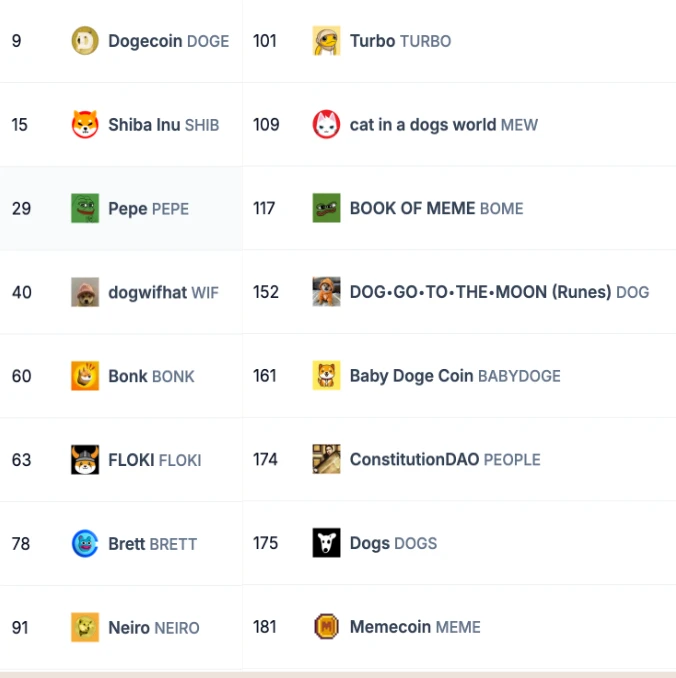
Specifically, $Neiro and $TURBO have very high dominance rates, with most liquidity on Binance. When Binance holds the vast majority of chips, it no longer needs to consolidate for accumulation and can immediately drive the market.
BRETT, MEW, and DOG are the remaining three tokens with relatively high dominance rates, all of which have recently achieved pattern changes or breakouts. BRETT broke out of a five-month downward channel, and MEW broke out of a seven-month downward channel. However, since their liquidity is not on mainstream exchanges, their post-breakout trends are not as strong compared to the Memecoins listed above. After breaking out, DOG maintained an upward channel for a month.
Due to dispersed liquidity, some tokens failed to maintain an upward channel after breaking out, which is unfortunate. For example, Pepe broke out of a seven-month consolidation period and is currently in a two-week horizontal box, performing relatively poorly compared to other hot Memecoins.
Additionally, other Memecoins that achieved price breakouts include Wif, Bome, DOGS, and DOGE. Among them, Wif is in a two-week upward channel, Bome is the most recently broken Memecoin dominated by Binance, and both DOGE and Bome broke out of a seven-month consolidation period, with expectations for their upcoming trends. DOGS is still in a three-month downward channel.
The remaining tokens that have been in a horizontal position for seven months without achieving a breakout include SHIB, BONK, and MEME. The more false breakouts occur, the higher the likelihood that the token cannot establish its independent trend and needs to rely on the overall market trend, indicating that when considering right-side buying, attention should be paid to stop-loss prices. People maintained a four-month horizontal position and also need to pay attention to the buying position when a price breakout occurs.
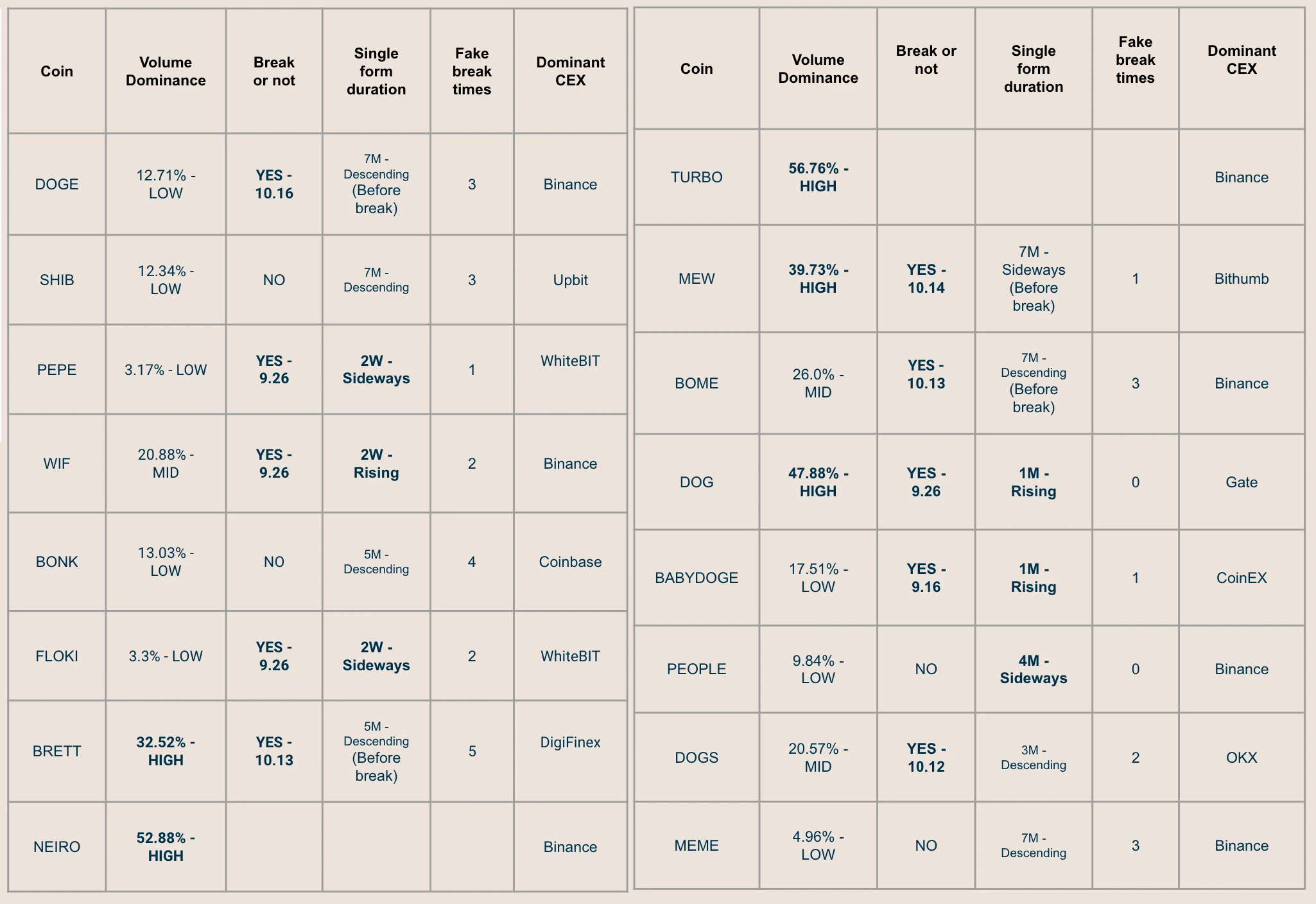
Summary
The Memecoin craze is far from over, but altcoins are by no means worthless. The question of whether focusing on fundamentals can bring corresponding returns in this cycle is still open-ended. This article introduced how to verify the commonalities in the development of hot Memecoins through on-chain data, hoping to highlight one possible future trend for Memecoins.
(All images in this article are created by the author. Please contact the author for use.)
About BlockBooster: BlockBooster is an Asian Web3 venture studio supported by OKX Ventures and other top institutions, dedicated to being a trusted partner for outstanding entrepreneurs. We connect Web3 projects with the real world through strategic investments and deep incubation, helping quality entrepreneurial projects grow.
Disclaimer: This article/blog is for reference only, representing the author's personal views and does not represent the position of BlockBooster. This article does not intend to provide: (i) investment advice or recommendations; (ii) offers or solicitations to buy, sell, or hold digital assets; or (iii) financial, accounting, legal, or tax advice. Holding digital assets, including stablecoins and NFTs, carries high risks, with significant price volatility, and they may even become worthless. You should carefully consider whether trading or holding digital assets is suitable for you based on your financial situation. If you have specific questions, please consult your legal, tax, or investment advisor. The information provided in this article (including market data and statistics, if any) is for general reference only. Reasonable care has been taken in compiling this data and charts, but no responsibility is accepted for any factual errors or omissions expressed therein.
免责声明:本文章仅代表作者个人观点,不代表本平台的立场和观点。本文章仅供信息分享,不构成对任何人的任何投资建议。用户与作者之间的任何争议,与本平台无关。如网页中刊载的文章或图片涉及侵权,请提供相关的权利证明和身份证明发送邮件到support@aicoin.com,本平台相关工作人员将会进行核查。




